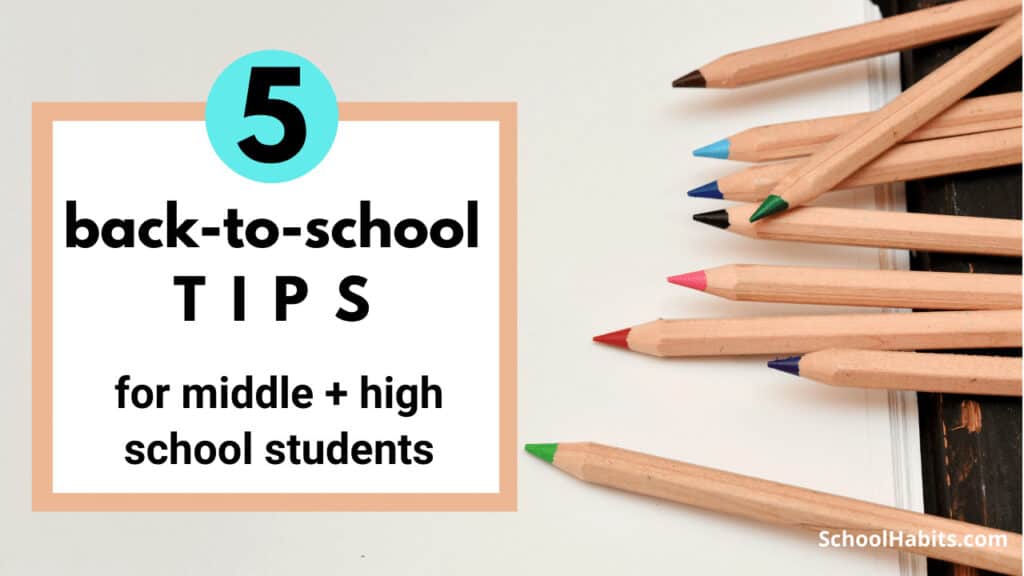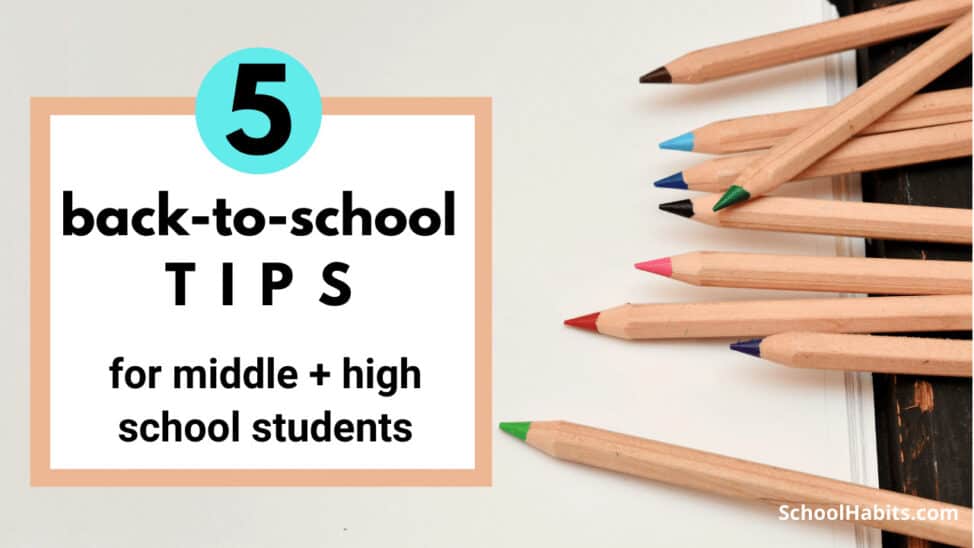By Katie Azevedo, M.Ed.

This post is full of back-to-school tips for middle and high school students. I have several back-to-school tutorials on my blog, so if you’re looking for more, check out these 10 tips and these 8 tips when you’re done reading about the strategies here.
The list below includes some out-of-the-box ideas to help you transition smoothly into your school year. Some of the strategies you should set up before school starts, while the others are more ongoing systems that you should keep up throughout the year.
Back to school tips for middle and high school students
1. Set up a synced family calendar
If you’re a middle school or high school student, you’re at the age when you should know what’s happening on the family calendar. If a parent is in charge of making your dentist appointments, you should at least know when they are. If your family has been invited to a relative’s birthday party, you should know when it is. Knowing what obligations your family has scheduled for the week or month is important to you being able to manage your own time. For example, if you plan to have friends over on the weekend to work on a group project, you need to know if your family is scheduled to be away at your cousin’s wedding those days.
Using a digital calendar like Google Calendar is great for this purpose, and it’s simple to set up with these instructions. If your family isn’t into digital calendars, then gather together once a week to communicate upcoming events and appointments. Write these down in your own calendar system.
2. Purchase your own books if you can
This back-to-school tip isn’t feasible for everyone, but if possible, purchase your own copies of the novels you read for English class – or any other class you read novels in. This website offers gently used books and decent prices. (This tip does not apply to textbooks, as those things are expensive!) I suggest you purchase your own copies of novels so that you can annotate directly in the books, which is by far the best approach to annotations. If you don’t know how to annotate and are still making these common annotation mistakes, you need to watch this and read this to learn how to take notes properly.
3. Set up and manage Google Drive properly
If you set up your Google Drive properly (or whatever storage system you use) from the beginning, you’ll be more likely to keep your files organized throughout the school year. Here are some basic tips for managing your drive:
- Delete all unnecessary files
- Give all unnamed files a proper name, or delete them
- Move all files from last year into appropriate folders (consider making a folder for each class you had last year)
- Create new folders for all your new classes
- Color-code your folders if you find that helpful
- Clean up your drive weekly or bi-weekly throughout the year
- Name all your new files this way
4. Figure out your class-materials system
Some students perform better when they combine all their class materials – for all classes – together in one giant binder. Other students prefer separate folders and separate notebooks for each subject. If you’re in middle school, your teachers may require you to do things a certain way, but if the choice is yours, you need to figure out what works best for you. If you often forget to bring the right materials home each night, then you probably want one large binder. (Students with ADHD – I’m talking to you!) If the thought of one massive binder freaks you out, then try something different. You might also consider notebooks vs loose-leaf paper in a binder, or 2-pocket folders vs 3-hole-punched papers. My point is that it’s on you to figure out what works, and then do that.
5. Get the right planner
There are multiple options for paper planners and digital apps, but the best ones are always the simplest. I suggest middle and high school students use a paper planner over an app, for so many reasons. Whatever you do, do NOT rely on your school’s learning management system (Canvas, Blackboard, Google Classroom) to track your homework; that is not what it’s for.
Paper planners should contain at least two components: a daily calendar for daily tasks and assignments, and a monthly calendar for long-term assignments and due dates. Here are my tips for picking a homework planner.
Final notes
Back-to-school season can bring out many emotions: excitement, hope, uncertainty, and even dread. It’s also perfectly normal to feel conflicting emotions at the same time. If you’re feeling overwhelmed or nervous to start a new year, one of the best things you can do is to get your outer systems in order. Sometimes when we clarify and organize our external systems (using a planner, keeping digital files organized, using a calendar, etc.) we feel better on the inside.

